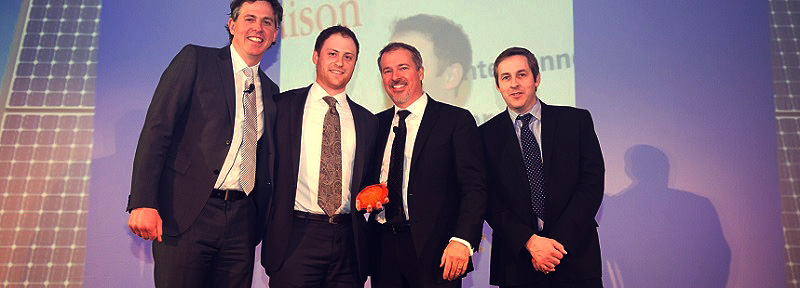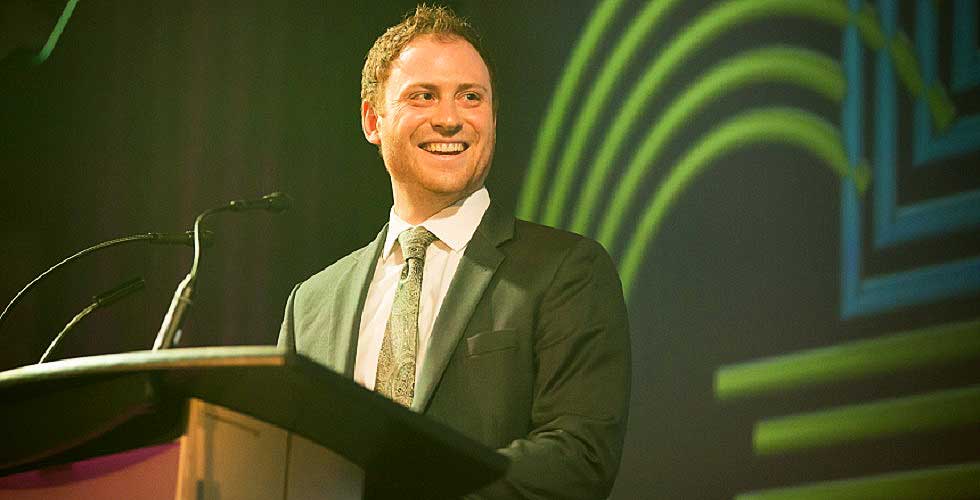There is an increasing role for young professionals to play in this industry. When I speak with students and recent grads, I am always impressed by their understanding of energy and sustainability issues.
— Jonathan Frank
Jonathan Frank
Jonathan Frank is a Director of Business Development at SunEdison, the world’s largest renewable energy company. He joined SunEdison’s Canada team in 2013 after three years helping grow one of Canada’s top solar energy engineering and construction companies, RESCo Energy. During this time he has helped bring solar energy projects to life with municipalities, school boards, non-profits, co-ops, and both small and large corporations.
Jonathan has also been an active member of the Canadian Solar Industries Association (CanSIA), particularly Emerging Leaders for Solar Energy (ELSE), the young professionals organization assembled by CanSIA . He was a founding executive and served as Co-Chair of the national board of directors in 2014-2015. ELSE’s mission is to empower and foster the next generation of Canada’s environment and business leaders.
He now advises ELSE as a past-chair and has increased his involvement within CanSIA’s various technical and policy working groups, including the Distributed Generation Task Force and the Climate Change Initiative. He is also a mentor within ELSE’s recently launched industry mentorship program.
The Award
 Jonathan (second from left) possess for a photo while holding the 2015 Game Changer award flanked (from left to right) by Greg Scallan, past chair of the CanSIA board of directors and SunEdison VP, CanSIA President and CEO, John Gorman, and Andrew van Doorn of Potentia Solar. Photo credit: CanSIA.
Jonathan (second from left) possess for a photo while holding the 2015 Game Changer award flanked (from left to right) by Greg Scallan, past chair of the CanSIA board of directors and SunEdison VP, CanSIA President and CEO, John Gorman, and Andrew van Doorn of Potentia Solar. Photo credit: CanSIA.Jonathan is the 2015 recipient of the CanSIA Game Changer Award for Emerging Solar Leader. The GameChanger awards are a rigorously competitive process with nominations, voting and selections administered by a third party.
“While I understand this award is for individual achievement I cannot accept sole credit,” said Jonathan. “I am very lucky to have amazing colleagues, both past (RESCo Energy) and present (SunEdison) as well as the ELSE team. They have been the best mentors, coaches, collaborators and friends anyone could ask for.”
While serving as co-chair of ELSE, the organization experienced a breakout year. Among many achievements and milestones the organization partnered with non-profit organization SunFarmer to fund and install a solar energy project on a health clinic in remote north-west Nepal where it serves as a game changer in its own right for the local community.
 ELSE project in Nepal, in partnership with SunFarmer. Photo courtesy of SunFarmer
ELSE project in Nepal, in partnership with SunFarmer. Photo courtesy of SunFarmer
ELSE also launched the industry’s first mentorship program, which pairs young professionals with industry leaders, and expanded its Solar Ambassador Network at Canadian universities and colleges, all while developing chapters in other provinces. ELSE now has over 1000 members across the country.
The Career
Jonathan’s decision to build a career in the solar industry can serve as inspiration for others, and even reads like something from a novel.
“Between undergrad and grad school, I was lucky enough to do some amazing travelling,” said Jonathan. “I took the trans-Siberian express across Russia and into Mongolia. Once in Mongolia I spent one week travelling the semi-Gobi desert and Mongolian-Manchurian steppe.”
“I became amazed by solar energy’s potential after staying with a local family who had a small solar panel.” Jonathan continued with a contagious smile. “It allowed them to have a cell phone to communicate to Ulaanbaatar, the capital city, to attract travelers (for tourism) like me as a source of income. And that additional income allowed them to send their children to school. The electric lights powered by the solar panels and a small battery enabled the children to study at night – avoiding the use of toxic kerosene lamps for light. It was then I began to see the transformative power of solar energy. The benefits were for this family exponential and the experience very inspiring and motivating for me.”
Coupled with his understanding of climate change issues Jonathan decided to pursue a career in renewable energy. Like so many others in the industry, he wanted to spend his time doing something that contributed positively to big, complex problems, like sustainable energy.
The Perspective
“Solar energy is becoming increasingly prolific,” says Jonathan. “In the last seven years the cost of solar panels has dropped by 75% while the performance has increased by 50%. It is now cheaper than coal for generating electricity in many parts of the world and this trend is accelerating. The International Energy Agency believes renewable energy sources, like solar and wind, will account for over half of the world’s electricity by 2030. That is a huge shift.”
Jonathan talked about the flexibility and scalability of solar energy as another key factor in the technology’s accelerating deployment. From a residential roof to utility scale power plants, the industry is seeing growth. “As energy storage, smart grid and electrified transportation technologies become increasingly viable, the integration of solar energy will become even easier.”
There are a lot of other indicators that solar energy is becoming more mainstream. “Increasingly, Fortune 500 companies are the leading adopters of solar energy, and corporate social responsibility is not always the driver. In many cases, it simply makes economic sense.” And as more traditional forms of electricity generation, such as coal, nuclear and natural gas become more expensive, solar energy and other renewables will look increasingly attractive.
“These are all key trends for students and young professionals to watch. Millennials will be about 75% of the global workforce by 2030 and this industry has potential to provide not only great job prospects, but meaningful careers.” For example, in the US, where solar is more advanced in usage than in Canada, jobs are growing ten times faster than the national average employment growth.
Our energy sustainability issues are not going to disappear on their own, and they are becoming increasingly complex as we learn more about the interdependence of energy, water, food, transportation and other vital systems.
— Jonathan Frank
“There is an increasing role for young professionals to play in this industry,” said Jonathan “When I speak with students and recent grads, I am always impressed by their understanding of energy and sustainability issues.”
 Jonathan, at what was in 2013 the largest rooftop solar project in Canada – Photo courtesy of Jonathan Frank and RESCo Energy Inc.
Jonathan, at what was in 2013 the largest rooftop solar project in Canada – Photo courtesy of Jonathan Frank and RESCo Energy Inc.Based on his own experience getting into the industry as well as his interactions with young people through ELSE he believes the industry can do more to provide a clear runway for recent grads and young professionals to follow. This is one of the motivating factors behind many of ELSE’s initiatives.
Many people look at what is happening in the energy sector and argue it is one of the major social, technical and economic transitions of our time. This is an exciting concept for young professionals. “As we learn more about sustainability within complex systems we learn more about the important interdependence of energy with other vital systems such as water, food, transportation and health care. This opens the door for greater collaboration between sectors and makes a career in renewable energy that much more relevant and exciting.”













Comments